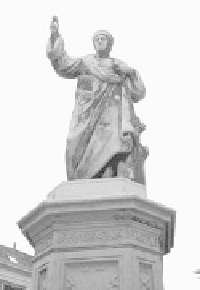Travel Reference
In-Depth Information
they credit their man, Coster, with invent-
ing modern printing. In the statue, Coster
(c. 1370-1440) holds up a block of movable
type and points to himself, saying, “I made
this.” How much Coster did is uncertain, but
Gutenberg trumped him by building a print-
ing press, casting type in metal, and pound-
ing out the Bible.
• Coster is facing the...
Town Hall:
While most of medieval
Europe was ruled by kings, dukes, and bar-
ons, Haarlem has been largely self-governing
since 1425. The town hall—built from a royal
hunting lodge in the mid-1200s, then rebuilt after a 1351 fire—has
served as Haarlem's town hall since about 1400. The facade dates
from 1630.
The town drunk used to hang out on the bench in front of the
town hall, where he'd expose himself to newlyweds coming down
the stairs. Rather than arresting the man, the townspeople simply
moved the bench (a typically Dutch solution to the problem).
• Next to the church is the...
Meat Market (V leeshal), 1603:
The fine Flemish Renaissance
building nearest the cathedral is the old meat hall, built by the rich
butchers' and leatherworkers' guilds. The meat market was on the
ground floor, the leather was upstairs, and the cellar was filled with
ice to preserve the meat. It's decorated with carved bits of early
advertising—sheep and cows for sale. Today, rather than meat, the
hall shows off temporary art exhibits (€5, Tue-Sun 11:00-17:00,
closed Mon, tel. 023/511-5775, www.dehallen.com).
sights
s
Church (Grote Kerk)
—
his 15th-century Gothic church (now
Protestant) is worth a look, if only to see Holland's greatest pipe
organ (from 1738, 100 feet high).
Its 5,000 pipes impressed both
Handel and Mozart. Note how
the organ, which fills the west
end, seems to steal l the show
from the altar. Quirky highlights
of the church include a replica
of Foucau lt 's pendu lu m, t he
“Dog-Whipper's Chapel,” and a
400-year-old cannonball.
To enter, find the small
Entrée
sign behind the church at






















